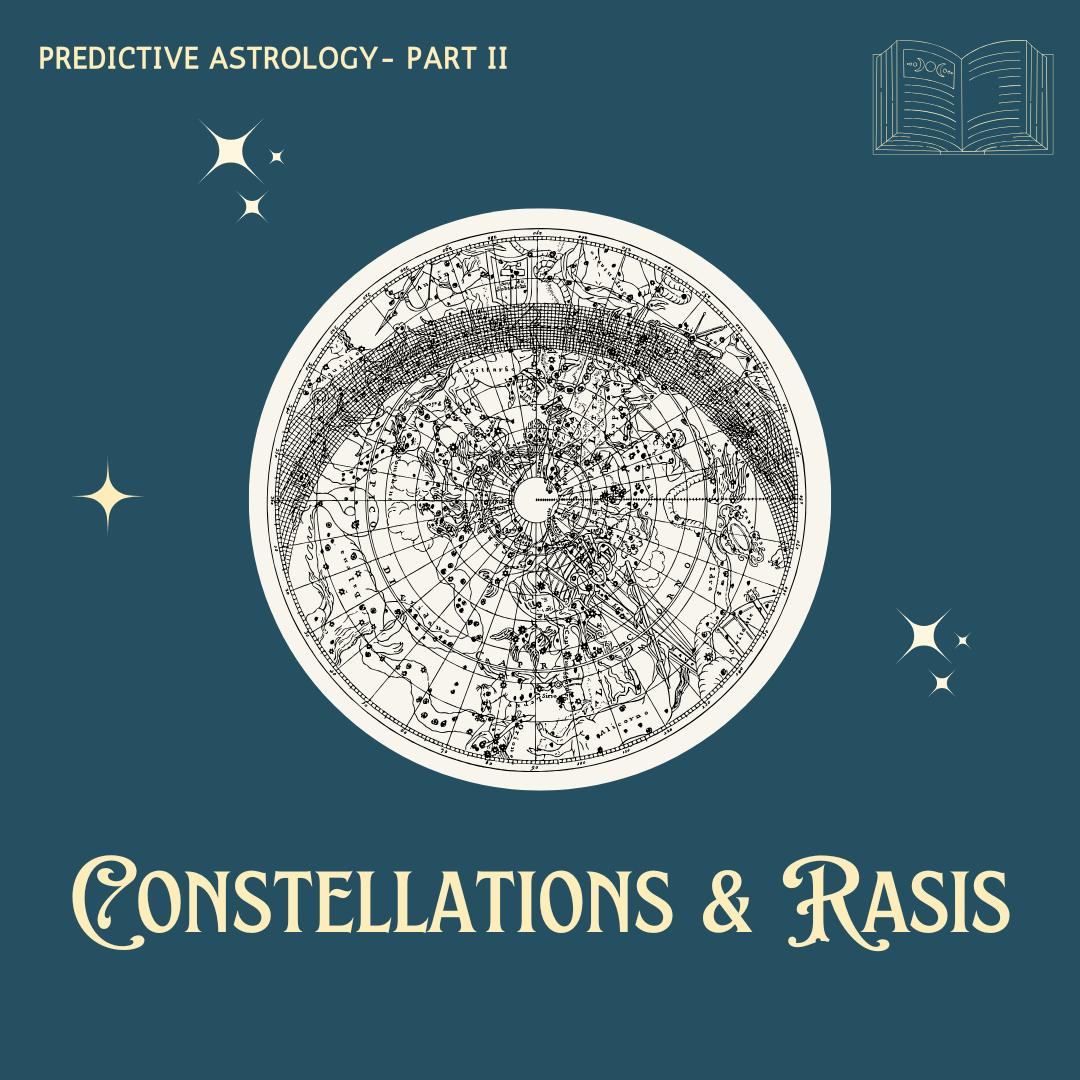The second volume in the "Predictive Astrology" series explores constellations, Ayanamsa, Nirayana, Sayana, the twelve Rasis, and their corresponding elements, rulers, symbols, and more.
Astrology is practiced in various forms around the world. In India, Vedic astrology is the most widely followed system. This ancient and traditional discipline offers profound insights into various aspects of life by analyzing the positions of planets, stars, and other celestial bodies. Vedic astrology uses the sidereal zodiac, whereas Western astrology follows the tropical zodiac. In this section, we delve into the foundational concepts of predictive astrology that are essential for accurate astrological interpretations.
Constellation:
A constellation is a group of stars that appear to form recognizable shapes or patterns in the night sky. Humans have historically associated these shapes with animals, mythological figures, and objects—for example, a bull or a scorpion. In astrology, portions of these constellations (approximately 2¾ of each) are grouped and represented as Rasis, or Zodiac Signs.
Ayanamsa (Ayanamsha):
The term Ayanamsa means “portion of movement” in Sanskrit. It refers to the angular difference between the tropical (Western) zodiac and the sidereal (Vedic) zodiac. This difference arises due to the precession of the equinoxes, a slow wobble in Earth's rotation, which causes the two zodiacs to gradually drift apart.
Currently, the Ayanamsa value is approximately 22 to 24 degrees, depending on the calculation method used. Among the various methods, the Lahiri Ayanamsa is the most widely used in Vedic astrology.
Sayana (Tropical Zodiac):
The Sayana system is primarily used by Western astrologers and is based on the tropical zodiac. In Sanskrit, Sayana means “with Ayanamsa,” indicating that this system includes the precessional movement in its calculations.
The tropical zodiac aligns with the Sun’s position relative to Earth’s seasons, beginning from the spring equinox. It reflects how the planets appear in the sky from a seasonal standpoint, rather than their actual positions against the backdrop of the constellations.
Nirayana (Sidereal Zodiac):
The Nirayana system is followed in Vedic astrology and is based on the sidereal zodiac. The Sanskrit term Nirayana means “without Ayana,” meaning the Ayanamsa is subtracted from the planetary positions.
This system considers the actual position of the constellations (fixed stars) in the sky. Because of the Earth's precession, it does not return to the exact same position relative to the fixed stars after one year; there is a shift of approximately 50 arc seconds per year.
Rasis or the Signs of the Zodiac:
Twelve such groups of constellations or stars (nakshatras), each with a distinct form and predominant characteristics, together form the Rasis or Zodiac signs. As we know, the positions of planets in the solar system are fixed in relation to each other—for example, Jupiter, Saturn, and Mars maintain consistent relative positions. Similarly, the positions of the Rasis or Zodiac signs are fixed in relation to one another; for instance, Karkataka (Cancer) always follows Mithuna (Gemini), and Simha (Leo) follows Karkataka (Cancer).
Below is the list of the twelve Rasis, along with their symbols, elements, planetary rulers, and corresponding zodiac names.
Mesha Rasi: Its zodiac name is Aries. It has fiery element with dynamic nature and is symbolized by Ram. It is ruled by the planet Kuja (Mars).
Vrishabha Rasi: Its zodiac name is Taurus. It is stable and determined with earthy elementlike a Bull. It is ruled by the planet Shukra (Venus).
Mithuna Rasi: Its zodiac name is Gemini. It represents duality and communication with air element and is symbolized by Twins. It is ruled by the planet Budha (Mercury).
Karkataka Rasi: Its zodiac name is Crab. It represents nurturing and intuitive nature with water element. It is symbolized by a Crab. It is ruled by Chandra (Moon).
Simha Rasi: Its zodiac name is Leo. It represents leadership and self expression with fire element. It is symbolized by a Lion. It is ruled by Surya (Sun).
Kanya Rasi: Its zodiac name is Virgo. It represents organization and practical nature with earth element. It is symbolized by a Virgin. It is ruled by the planet Budha (Mercury).
Tula Rasi: Its zodiac name is Libra. It represents balance and hormony with air element. It is symbolized by Scales. It is ruled by the planet Shukra (Venus).
Vrischika Rasi: Its zodiac name is Scorpio. It represents transformation with water element. It is symbolized by Scorpio. It is ruled by the planet Kuja(Mars).
Dhanu Rasi: Its zodiac name is Saggitarius. It represents expansiveness and optimisim with fire element. It is symbolized by Archer. It is ruled by the planet Guru(Jupiter).
Makara Rasi: Its zodiac name is Capricorn. It represents boldness and ambition with an earth element. It is symbolized by Sea goat. It is ruled by the planet Sani (Saturn).
Kumbha Rasi: Its zodiac name is Aquarius. It represents innovation and progressive thinking with an air element. It is symbolized by Water bearer. It is ruled by the planet Sani(Saturn).
Meena Rasi: Its zodiac name is Pisces. It represents spiritual and compassion with a water element. It is symbolized by Fish. It is ruled by the planet Guru (Jupiter).
